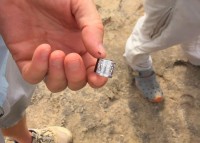2018 Peregrine Migration Study: So. Padre Island
September 29, 2018 in Near the Clock Tower
Thanks to Geoff Pampush from The Peregrine Fund located in Boise, Idaho, we had a very enjoyable opportunity to join the 2018 Peregrine Falcon Migration Study survey team on South Padre Island for two days at the end of September.
Each fall, as part of a long-term research program on Peregrine Falcons, a survey team assembles on South Padre Island, Texas, to observe and monitor the movement of the highly migratory tundra Peregrine Falcons. The survey team members assess and monitor the health and dynamics of this sentinel species.
Three subspecies of Peregrines nest in North America: the pealei subspecies Falco peregrinus pealei, the anatum subspecies Falco peregrinus anatum, and the tundrius subspecies Falco peregrinus tundrius.
Members of the pealei subspecies nest on the coast of Alaska and British Columbia, and are mostly resident, or only slightly migratory. Members of the anatum subspecies nest south of the tree line throughout the remainder of continental North America, and are migratory in northern areas and resident farther south. Members of the tundrius subspecies nest from Alaska to Western Greenland and are highly migratory arctic birds.
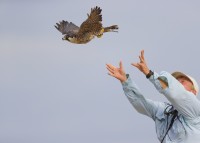 The annual survey field work on South Padre Island, is scheduled during both the spring and fall migration. In spring 2017, survey team members expended 191 survey hours in the field, recording 457 sightings and capturing 36 individual peregrines. In the fall of 2017, the survey team expended 429 survey hours, recording 635 sightings, and capturing 131 individuals.
The annual survey field work on South Padre Island, is scheduled during both the spring and fall migration. In spring 2017, survey team members expended 191 survey hours in the field, recording 457 sightings and capturing 36 individual peregrines. In the fall of 2017, the survey team expended 429 survey hours, recording 635 sightings, and capturing 131 individuals.
The study area includes the northern 25 miles of undeveloped land on South Padre Island in an area administered by the Laguna Atascosa National Wildlife Refuge. In total, the Laguna Atascosa NWR covers just over 98,000 acres in southwest Texas. Survey efforts concentrate on the extensive tidal flats west of the barrier dunes along the eastern shore of South Padre Island.
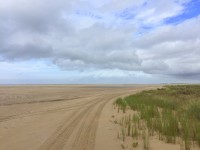 South Padre Island is one of the longest barrier islands in the world and is continually being reshaped by wind, waves and the currents. The barrier island’s habitat transitions from sandy beaches to dunes, to broad tidal mud flats bordering the Lower Laguna Madre. The brackish marshes and freshwater ponds bordering the dunes are replenished by rain, an important freshwater source for many species.
South Padre Island is one of the longest barrier islands in the world and is continually being reshaped by wind, waves and the currents. The barrier island’s habitat transitions from sandy beaches to dunes, to broad tidal mud flats bordering the Lower Laguna Madre. The brackish marshes and freshwater ponds bordering the dunes are replenished by rain, an important freshwater source for many species.
South Padre Island is extremely important for many reasons, including its significance to nesting Kemp’s Ridley sea turtles. Also, Peregrine Falcons, on their migration to and from South America, ‘stage’ here – the majority of the peregrine population stops at one time or other on the Island to refuel during their long migration. Many neotropical migratory birds also ‘fall out’ on Padre Island.
 The Padre Study is conducted during the peak of both spring and fall migration. Survey team members utilize All-Terrain Vehicles, and typically deploy daily from dawn to dusk, based on weather conditions. Sightings of all peregrines are noted according to date, time, location, species, sex, age, and activity.
The Padre Study is conducted during the peak of both spring and fall migration. Survey team members utilize All-Terrain Vehicles, and typically deploy daily from dawn to dusk, based on weather conditions. Sightings of all peregrines are noted according to date, time, location, species, sex, age, and activity.
- Marking of unbanded individuals with U.S. Geological Survey (USGS) nine-digit silver leg bands, or recording of existing band information (from prior banding)
- Determine age and sex of bird according to Bird Banding Laboratory guidelines
- Collection of a 2ml blood sample from the brachiocephalic vein; for contaminant, infectious disease, and genetic analyses
- Collection of feather samples for contaminant and natal origin studies
- Collecting morphologic measurements.
Geoff and I joined two of the very experienced survey team members on Wed. Sept. 26th and Thursday Sept. 27th. On Wednesday, we set out in the mid-afternoon and returned to the base camp well after dark. On Thursday we got started first thing in the morning, and arrived back at base camp just before sunset, after a series of torrential rainstorms during the day.
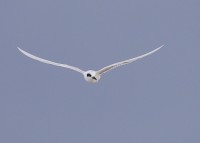 In the very final stretch of making our way back along the beach, to the transport truck and trailer, soaking wet in the ATV’s, the clouds started to break up, and the sun started to peek through the clouds. We all paused for a grace-filled moment to watch the full arc of a dazzling rainbow, as a group of horseback riders made their way southbound on the beach along the wrack line, while Brown Pelicans, Caspian and Forster’s Terns, and many Laughing and Ring-billed Gulls were diving into the surf just offshore.
In the very final stretch of making our way back along the beach, to the transport truck and trailer, soaking wet in the ATV’s, the clouds started to break up, and the sun started to peek through the clouds. We all paused for a grace-filled moment to watch the full arc of a dazzling rainbow, as a group of horseback riders made their way southbound on the beach along the wrack line, while Brown Pelicans, Caspian and Forster’s Terns, and many Laughing and Ring-billed Gulls were diving into the surf just offshore.
On Wednesday, we sighted 18 peregrines, and banded two. On Thursday, with fresh winds out of the north, and a series of dramatic changes in the weather, we had 15 peregrine sightings along with the capture, processing, and release of two After Hatch Year female tundra peregrines.
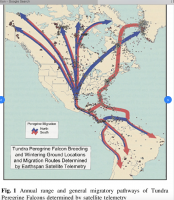 The extraordinary annual migration phenomenon of the tundra Peregrines is fascinating beyond words. These high latitude tundra peregrines nest across North America from Alaska to western Greenland. They spend the winter months in central US, and farther south to Central and South America. Individual falcons may travel over 18,500 miles per year. They utilize critical migration stopover habitats, including South Padre Island, to rest and refuel during migration.
The extraordinary annual migration phenomenon of the tundra Peregrines is fascinating beyond words. These high latitude tundra peregrines nest across North America from Alaska to western Greenland. They spend the winter months in central US, and farther south to Central and South America. Individual falcons may travel over 18,500 miles per year. They utilize critical migration stopover habitats, including South Padre Island, to rest and refuel during migration.
The full recovery of the Peregrine Falcon is one of the most dramatic success stories for an Endangered Species. The population of these falcons was decimated from exposure to DDT in insecticides. A successful recovery effort resulted in removal from the federal Endangered Species list in 1999.
The continuation of essential monitoring efforts will advance the understanding of Peregrine Falcon population dynamics. Although the Peregrine is no longer listed as endangered or threatened at the federal level, it is so important to recognize its role as a sentinel species for overall environmental conditions. These conditions impact a myriad of other avian species.
Cited references: South Padre Island Peregrine Falcon Survey Annual Report, Earthspan Foundation/The Peregrine Fund, 2017
Please visit the Earthspan Foundation website at www.earthspan.org as well as The Peregrine Fund website at www.peregrinefund.org for more information on the North American Migratory Peregrine Studies.
